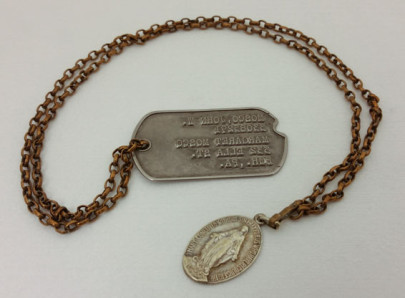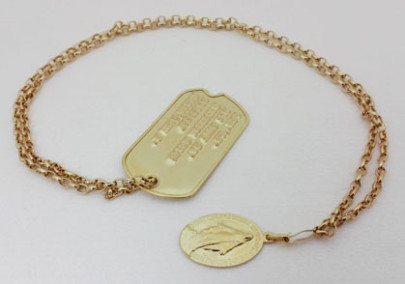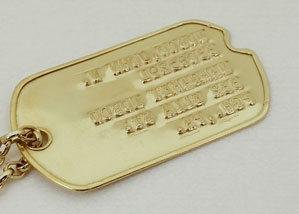History of dog tags
Military identification tags, or “dog tags” as they are known, contain important information about the soldier such as name, spouse, social security number, address and religious preference. Dog tags go back as early at the American Civil War. The army did not provide i.d. tags, so soldiers would write their name and other personal info on a handkerchief and pin it to their jackets before battle. They were afraid that if they were killed in action, their families wouldn’t know what happened to them. Manufacturers took note of this and began selling custom made circular i.d. tags made of brass or lead. Soldiers continued buying their own i.d. tags until the end of World War I, when the U.S. Army began issuing a pair of aluminum tags to each soldier. If killed in battle, one tag remained with the body, while one tag remained with the record keeper. WWII dog tags were made from stainless steel, rectangular in shape with a notch at one end. Contrary to popular belief, this notch was not intended to be placed between the front and lower teeth of a dead soldier. The notch was a simply a by product of the stamping machine process used to make them.

More than just identification
Anyone who has served or has family that has served knows that dog tags are more than just an identification, they are a source of identity. The person they were before boot camp was definitely not the same person they were before. Dog tags embody that experience and transition. For those who grew up during the depression and fought in WWII and Korea, they were probably also the first pair of jewelry that they had ever owned.
A chain of memories over time
This WWII dog tag, religious pendant and brass chain belonged to the owner’s father. According to him, they saw all 4 years in the Pacific Theater of WWII. Through good, bad and horrific they were worn; if only these heirlooms could talk. The brass chain is original from that era, of good construction, but highly corroded. The religious pendant is made of brass and was plated with silver. The dog tag is stainless steel, deeply oxidized but in good shape.

A respectful and loving restoration in gold
We started by disassembling the dog tags and pendant from the chain. We began the restoration process by removing all oxidation and surface grits. This is an important step as we are interested in preserving all surface detail and contours of the dog tags, chain, and religious pendant. Since each piece is made from a different metal, each required a completely different cleaning steps and de-oxidation processes. After cleaning a gentle polishing process was used designed specifically to bring out the design detail and to brighten the appearance. A careful balance between brightening and preserving the “battle scars” was required. It is important practice for our team to avoid needless “over restoration” of vintage and heritage pieces. For the final step each piece was pre-plated in a metal suitable to seal the base metal and to improve the adhesion of the new gold plating. For the gold plating we selected a 14kt “Hamilton gold” color. This paler color of gold was widely used by the Hamilton watch company throughout the 1940’s and into the 1960’s. In fact if a soldier chose to wear a gold watch, it is highly likely that it was a 14kt Hamilton gold color as it was used by numerous watch companies. Authentic to the WWII era, we believed that it is a perfect color of gold for this project. Once all the pieces were re-plated, we reassembled them back to their original place on the chain. As you can see, the pieces are now preserved by a layer of gold, in the perfect color, authentic to the era.
Metal Arts Specialties
+1 (248) 821-3450
Email
8AM–6PM EST


